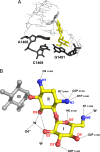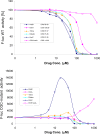Structure-activity relationships among the kanamycin aminoglycosides: role of ring I hydroxyl and amino groups
- PMID: 22948879
- PMCID: PMC3497201
- DOI: 10.1128/AAC.01326-12
Structure-activity relationships among the kanamycin aminoglycosides: role of ring I hydroxyl and amino groups
Abstract
The kanamycins form an important subgroup of the 4,6-disubstituted 2-deoxystreptamine aminoglycoside antibiotics, comprising kanamycin A, kanamycin B, tobramycin, and dibekacin. These compounds interfere with protein synthesis by targeting the ribosomal decoding A site, and they differ in the numbers and locations of amino and hydroxy groups of the glucopyranosyl moiety (ring I). We synthesized kanamycin analogues characterized by subtle variations of the 2' and 6' substituents of ring I. The functional activities of the kanamycins and the synthesized analogues were investigated (i) in cell-free translation assays on wild-type and mutant bacterial ribosomes to study drug-target interaction, (ii) in MIC assays to assess antibacterial activity, and (iii) in rabbit reticulocyte translation assays to determine activity on eukaryotic ribosomes. Position 2' forms an intramolecular H bond with O5 of ring II, helping the relative orientations of the two rings with respect to each other. This bond becomes critical for drug activity when a 6'-OH substituent is present.
Figures


Similar articles
-
Analysis of the contribution of individual substituents in 4,6-aminoglycoside-ribosome interaction.Antimicrob Agents Chemother. 2005 Dec;49(12):5112-8. doi: 10.1128/AAC.49.12.5112-5118.2005. Antimicrob Agents Chemother. 2005. PMID: 16304180 Free PMC article.
-
Glycodiversification for the optimization of the kanamycin class aminoglycosides.J Med Chem. 2005 Oct 6;48(20):6271-85. doi: 10.1021/jm050368c. J Med Chem. 2005. PMID: 16190754
-
Structure-function comparison of Arbekacin with other aminoglycosides elucidates its higher potency as bacterial translation inhibitor.Sci Rep. 2025 May 25;15(1):18271. doi: 10.1038/s41598-025-02391-3. Sci Rep. 2025. PMID: 40415027 Free PMC article.
-
Effects of 5-O-Ribosylation of Aminoglycosides on Antimicrobial Activity and Selective Perturbation of Bacterial Translation.J Med Chem. 2016 Sep 8;59(17):8008-18. doi: 10.1021/acs.jmedchem.6b00793. Epub 2016 Aug 19. J Med Chem. 2016. PMID: 27509271
-
Targeting RNA with small molecules.Chembiochem. 2003 Oct 6;4(10):998-1007. doi: 10.1002/cbic.200300680. Chembiochem. 2003. PMID: 14523917 Review. No abstract available.
Cited by
-
Prediction of Premature Termination Codon Suppressing Compounds for Treatment of Duchenne Muscular Dystrophy Using Machine Learning.Molecules. 2020 Aug 26;25(17):3886. doi: 10.3390/molecules25173886. Molecules. 2020. PMID: 32858918 Free PMC article.
-
Aminomethyl spectinomycins as therapeutics for drug-resistant respiratory tract and sexually transmitted bacterial infections.Sci Transl Med. 2015 May 20;7(288):288ra75. doi: 10.1126/scitranslmed.3010572. Sci Transl Med. 2015. PMID: 25995221 Free PMC article.
-
Prospects for circumventing aminoglycoside kinase mediated antibiotic resistance.Front Cell Infect Microbiol. 2013 Jun 25;3:22. doi: 10.3389/fcimb.2013.00022. eCollection 2013. Front Cell Infect Microbiol. 2013. PMID: 23805415 Free PMC article. Review.
-
In vitro and in vivo Evaluation of Synergism between Anti-Tubercular Spectinamides and Non-Classical Tuberculosis Antibiotics.Sci Rep. 2015 Sep 14;5:13985. doi: 10.1038/srep13985. Sci Rep. 2015. PMID: 26365087 Free PMC article.
-
Phenotypic Differentiation Within the aac(6') Aminoglycoside Resistance Gene Family Suggests a Novel Subtype IV of Contemporary Clinical Relevance.Antibiotics (Basel). 2024 Dec 8;13(12):1196. doi: 10.3390/antibiotics13121196. Antibiotics (Basel). 2024. PMID: 39766586 Free PMC article.
References
-
- Bastida A, et al. 2006. Exploring the use of conformationally locked aminoglycosides as a new strategy to overcome bacterial resistance. J. Am. Chem. Soc. 128:100–116 - PubMed
-
- Blount KF, Zhao F, Hermann T, Tor Y. 2005. Conformational constraint as a means for understanding RNA-aminoglycoside specificity. J. Am. Chem. Soc. 127:9818–9829 - PubMed
Publication types
MeSH terms
Substances
LinkOut - more resources
Full Text Sources
Other Literature Sources
Medical

